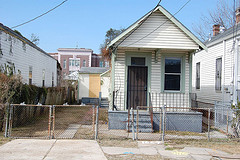By Karen Gadbois, The Lens staff writer|
The list of Road Home properties at risk of demolition is nothing new. It appears on the website of the Louisiana State Historic Preservation Office, and is updated from time to time by CDM, the contractor that manages the demolition process.
The list is a way of letting neighborhoods know what gaps may soon appear in the post-Katrina streetscape. CDM also invites suggestions on ways to “minimize or mitigate any adverse effects.”
But the list’s latest iteration, flagged in an email from CDM, came with a surprise twist: “Many of these properties will be offered at public auction on Saturday, April, 2,” the email said.
Preservationists might be expected to applaud a decision that gives the properties, some of them classic New Orleans houses, shot at rehabilitation.
Not Hal Brown – and for good reason. On Wednesday, Brown, a developer and preservationist, was startled to find on the list a house on North Miro Street that he bought in September 2009 and in February 2010 secured permits to fix up.
Contact with the State Historic Preservation Office (SHPO) and CDM suggested that the glitch was not the only confusion surrounding the impending auction.
For starters, Brandon Badinger, the “Historic Preservation Specialist, was not prepared to concede that listing Brown’s property was a mistake at all. While demolition is a “last resort,” Badinger wrote in an email, the fact that Brown has taken out city repair permits does not remove the threat of the wrecking ball.
“ … Permitting with the city of New Orleans is a separate and unrelated action unless the HDLC (Historic District Landmarks Commission) has approved the renovation,” Badinger advised. “If the HDLC has no jurisdiction then we need to review and comment on any changes to the exterior of the building including additions.”
Browns property is not under HDLC jurisdiction.
The SHPO website list included a link to the NORA website, the agency in charge of the disposition of Road Home properties situated in New Orleans.
The link to NORA sends you to another link, which connects to the company facilitating the potential sale, Gilmore Auctions.
That site gives visitors a chance to view the properties proposed for the auction and announces that the bidding for any property starts at $1,000 dollars.
Well, maybe not. Jasmine Haralson, Intergovernmental and Community Relations Manager for NORA said the $1,000 floor is to encourage participation, but that in reality “a reserve price will be established for each property.” A reserve price is the actual floor below which bids will not be accepted.
Patty Gay Executive Director of the Preservation Resource Center said she was “pleased that the 90 properties were going up for auction” and was hoping the remaining 4,000 properties in NORA’s portfolio would also be put on the block. She expressed concern, however, about the reserve price being too high. Her worry: that “the minimum accepted bid will be more than fair market value.”
People come to auctions looking to pay no more than fair market value – if that. She said she hoped minimums would reflect that reality.
City Councilmember Kristin Giselson Palmer, an advocate of auctioning as an alternative to demolition, shared Gay’s view. “The intent of the sale is to get properties into the hands of responsible owners.”
In Brown’s view, that’s exactly what he is, a responsible owner. He said he has assembled a collection of six properties in the Bayou St. John area and, having secured financing, is now about to begin repairs.
As for the Miro Street house, “I really can’t answer why it ended up on the list,” said Mike Taylor, of the Louisiana Land Trust, the non-profit agency set up to handle Road Home properties statewide, funneling its New Orleans holdings through NORA. But the onus is on Brown to notify SHPO of permits or other steps leading to rehabilitation of a Road Home property, Taylor said.
Meanwhile, if other mistakes are spotted on the list submitted for auction, the eagle-eyed should contact the Land Trust or NORA, Taylor said.

